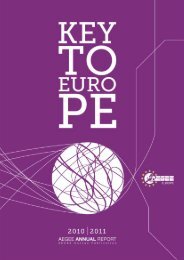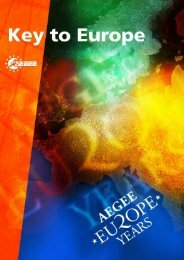turkish-greek civic dialogue - AEGEE Europe
turkish-greek civic dialogue - AEGEE Europe
turkish-greek civic dialogue - AEGEE Europe
Create successful ePaper yourself
Turn your PDF publications into a flip-book with our unique Google optimized e-Paper software.
140<br />
EXAMINING THE LAUSANNE<br />
CONVENTION<br />
........................................................................................................... Renée Hirschon<br />
St Peter’s College, University of Oxford<br />
This speech given by Renée Hirschon on the 7 th and<br />
8 th November 2003 is about the Greek - Turkish<br />
compulsory population exchange as agreed in the<br />
Lausanne Convention in 1923. When giving the speech<br />
the speaker intended to examine the consequences<br />
of the above-mentioned Convention and to see what<br />
we can learn from this example of forced migration<br />
that could be proven useful in a similar situation in<br />
the future.<br />
Having lived for a year in a neighborhood of Piraeus<br />
in the 1970s, the speaker had the opportunity to<br />
socialise with forced migrants from Turkey and<br />
to gather some of their opinions on the particular<br />
subject. After listening to many stories by those of<br />
the elder generation who remembered actual facts<br />
and could share their experiences, she reached some<br />
conclusions.<br />
Very often, she would hear interesting stories describing sweet memories of<br />
the past. What she found very important was the fact that those people were<br />
able to understand and live with diversity, as it was a basic characteristic of<br />
the society they had lived in up to the 1920s. Until then, people had learned<br />
to live without expressing hostility towards others who behaved in a different<br />
way as their society had always been multicultural.<br />
Habits of every group of population were easily accepted by others, while<br />
stereotypes did not exist. The ‘unmixing’ of mixed populations though led to<br />
the destruction of multicultural societies, thus creating two different national<br />
identities. Numerous are the claims of people that describe their relations with<br />
the Turks and other populations friendly. This is not only proven by people’s<br />
statements, but also found in many different sources such as historical archives.<br />
However, the memories would not always be sweet and agreeable. The elder<br />
generation had not forgotten cases of killings, manslaughter, rapes or even the<br />
great fires and everything that forced them to migration.<br />
Nevertheless, what seems to be very important and yet strange is that those<br />
people did not put the blame on Turks in general. On the contrary, they knew<br />
that what happened then was the governments’ fault. It is very impressive to<br />
see how balanced their good and bad memories are.<br />
Some claim that the co-existence of different groups of people might result in<br />
conflicts, but according to the speaker, it could only result in the forming of a<br />
more sophisticated society, which can recognize and accept diversity, as social<br />
contacts tend to reduce prejudice against groups of population, under given<br />
circumstances.<br />
As for the hostility between the two nations, which is currently apparent, it<br />
is obvious that it has been created by those who wrote each nation’s history<br />
and some groups of people who have extreme beliefs. It is certain that modern<br />
multicultural societies have still much to learn from those older ones.<br />
SOCIAL AND CULTURAL INFLUENCES FORM<br />
THE SETTLEMENT OF THE ÉMIGRÉS,<br />
......................................................................................... SIA ANAGNOSTOPOULOU<br />
As it is already common knowledge, the vast population movements are a<br />
result of important subversions occurred in the history of a region, whilst the<br />
settlers become subversions themselves for the history of the hosting regions.<br />
The population movement from and towards Near East (TR), mainly between<br />
1922-1924, confirms this general assumption.<br />
Since 1922 until the Treaty of Lausanne and the population exchange, 1923-<br />
Population Exchange Association des Etats Généraux des Etudiants de L’<strong>Europe</strong>







